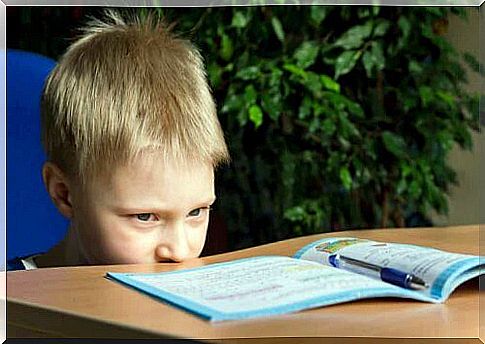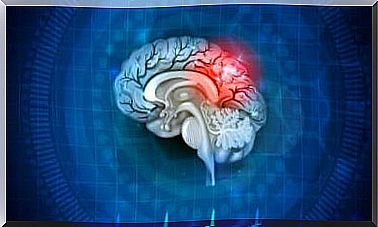Dysgraphia: Types, Causes And Treatments

Dysgraphia is a neurological disorder that makes writing difficult. It covers the general machinery of written transcription, that is, handwriting, typing and spelling. It is estimated that 5% to 20% of young students have some type of writing deficit, but the exact prevalence of dysgraphia is not yet known.
Most children find it difficult to write as it is a skill that requires learning and practice. However, if a child’s handwriting is too messy or if he displays his ideas in a haphazard way despite all his efforts, he may have the disorder. Stay with us and find out everything about this condition.
What are the symptoms?
Dysgraphia impairs the ability to write, but it also modifies the coherence of written words. This is because, if the child has to focus all their attention on the transcription, the ability to express concepts and ideas can become more laborious. Therefore, it is a disorder that makes it difficult to master writing in general.
The Understood.org portal exposes some of the most common signs of dysgraphia. Among them, we find the following difficulties:
- Form letters correctly.
- Place spaces consistently between letters on the page.
- Write straight.
- Keep the font size uniform throughout the text.
- Continuously erase what has been written.
- Complications in maintaining spelling guidelines : This includes incomplete words, misspellings, and placement or absence of letters.
In addition to the problems reflected on the paper, a child’s posture also says a lot about his writing ability. A child with dysgraphia will hold the pencil in an unusual way, and will assume awkward postures when writing or orient the paper incorrectly.

Types of dysgraphia
As indicated by the Special Needs portal , there are several types of dysgraphia. We detail them all below:
- Dyslexic : Spontaneous word formation is illegible, but copied sentences are often understood.
- Motor : Caused by lack of motor skills and muscle tone. Own and copied sentences are often illegible. Patients can form sentences, but this requires a lot of effort and dedication.
- Spatial : as the name suggests, the child cannot understand the concept of spacing, so he joins sentences together and has difficulty maintaining the spacing between lines and margins. However, the sentences are understandable and the letters follow a coherent order.
- Phonological : characterized by the difficulty in writing and spelling complex new words. These children are not able to memorize phonemes.
- Lexical : is a very rare form of dysgraphia in which words written as they sound are well understood but irregular words are not. It is more common in English and French.
What is the cause?
Finding the cause of dysgraphia in children can be a big challenge. However, if it is acquired in adults, it could be due to brain damage, tumors, strokes and other events involving the brain.
There are two main suspicions of dysgraphia motives in children: neurological and motor. The first case is not necessarily serious, as sometimes there are certain slight imbalances that prevent the correct ordering, which hinders the child’s written communication. Several pathologies have been associated with dysgraphia, such as attention deficit hyperactivity disorder (ADHD).
The psychomotor or motor causes can be a little more delicate, as there are several congenital diseases that cause progressive muscular dystrophy, for example.
How is dysgraphia diagnosed?
The ADDitude portal , specialized in ADHD, reveals that the diagnosis of dysgraphia is made in a standardized way through the assessment of Specific Learning Disorder (SLI). For a child to enter the named criteria, he must meet the following 4 pillars:
- Show at least 6 of the standardized symptoms that hinder learning for at least 6 months.
- Show significantly reduced academic skills compared to the rest of peers. This should hinder your performance at school.
- The difficulties must have started in the school environment, although they become more important in professional life.
- Other possible illnesses such as blindness should be ruled out.
Treatment
Dysgraphia is a condition that accompanies a child throughout life, and there is no cure. The approach, both at school and at home, is to encourage practice and skill development. However, the condition cannot be corrected with medication or surgery.
Just because it’s permanent doesn’t mean it can’t get better. In these cases, occupational therapy is generally recommended, in which the therapist will help the child to write better and adopt more effective postures. In addition, the school must offer special educational cycles according to your needs.

Tips to improve writing
Finally, we give some tips that can be applied to a child with dysgraphia to facilitate learning for him and for educators. The LDonline.org portal presents many options:
- Give the child a piece of paper with established lines so that it is easier for him to follow a coherent structure in writing.
- Allow her to experiment with different types of pens and pencils until she finds one she feels comfortable with.
- Begin the writing process with the child, but expressing ideas in the form of drawings and pictures.
- Teach your child various writing techniques and verb tenses. She can settle for what’s easiest for her.
- Don’t focus on copying sentences as it is better to promote autonomy and practice.
Dysgraphia is chronic but treatable
Trying to summarize the particularities of this disorder in a few lines is a challenge, as it is a very complex and varied clinical condition. If you have dysgraphia or your child has signs, we advise you to review the pages already cited, especially regarding the approach at home.
The fact that dysgraphia is lifelong doesn’t mean we can’t treat it. Therefore, therapy and practice will be the best allies for a child with the problem. With patience and dedication, the patient can achieve a certain degree of autonomy when writing.









